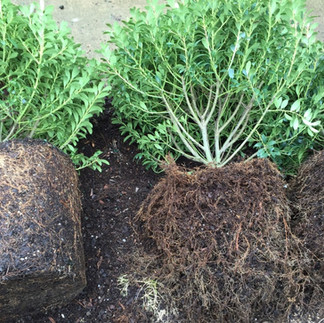Native Plant Garden 10 Years In: Lessons Learned Growing Evergreen Shrubs
- Nuts for Natives
- Feb 14, 2024
- 3 min read
Finding just the right conditions for each.

Over the ten years in this garden, I have intentionally planted as many evergreens as possible to screen out the nearby intersection and add color and structure, particularly for the depths of winter! Early on, I mostly paid attention to the light the various shrubs required. I soon realized it would be necessary to pay close attention to the soil conditions as well - not only moisture, but also alkaline versus acidic soils. Our garden is, as best as I have determined, a lot of fill with clay covered by ten years worth of decomposing leaves and still alkaline. There has been a lot of trial and error and while I am sharing my experience, this is where going to a native plant nursery and talking to the staff about your conditions, will really pay off. Evergreen shrubs can be slow growing and are investments. It makes sense to get it right from the start!
Drooping Laurel

Drooping laurel (Leucothoe fontanesiana), also called dog hobble, is a small evergreen shrub that grows well in shady, moist areas and acidic soils. Mt. Cuba says this shrub can also take sun. This shrub makes a great native substitute for the ubiquitous non-native cherry laurel (Prunus ‘Otto Luyken’, Prunus laurocerasus and Prunus laurocerasus ‘schipkaensis’).
Lesson learned: Drooping laurel seems to do better in moister areas when soils are not acidic. I planted one in average moisture soils and it stagnated. Once moved to my friend Alice's garden, located in a part sun area with more water, it took off.
Lesson learned: Seems to transplant easily!
Eastern Red Cedar "Grey Owl'

Eastern red cedar ‘Grey Owl’ (Juniperus virginiana ‘Grey Owl‘) is a short, horizontally growing shrub version of the tall native tree, Eastern red cedar. This shrub grows and fruits best in full sun and will handle just about any type of soil. It grows a couple of feet high and 4 to 6 feet wide. This shrub does not get cedar rust like Eastern red cedar trees do. The blue fruits persist through winter - delightful.
Lesson learned: Plant it where you can see and enjoy the berries all winter long, but in full sun!
Inkberry

Inkberry (Ilex glabra) is an all around strong evergreen shrub. The straight species grows to 5 to 6 feet tall and wide. A number of smaller cultivars are also available. Inkberry can be grown as a hedge, foundation plant or a specimen plant. Inkberry is said to grow in full sun or part shade in average moisture.
When it is thriving, this very versatile evergreen is very low maintenance. It also makes a great substitute for boxwood.
Lesson learned: In our clay soils, it grows much stronger in full sun. In shade, the plants grow very slowly and are not as full.
Lesson learned: It is far better to purchase smaller plants, like those typically found at native plant nurseries, than the one gallon and larger sizes found at garden centers. The smaller plants establish much more readily and after a couple of years, are equally robust. Often times, larger inkberries at garden centers have been in their pots for quite sometime and are somewhat root bound. These are more difficult to get established.
Mountain Laurel

Mountain laurel (Kalmia latifolia) is another incredible evergreen shrub for shade and moist acidic soils. It grows upwards of 8 to 10 feet and flowers range in color from white to pink to red. It is also a slow growing shrub.
Lesson learned: I have not been able to get it to grow in our alkaline clay soils. If I were going to try again, I would amend the soil heavily with compost and use a soaker hose until the shrub established.
Rhododendron

Rosebay rhododendrons (Rhododendron maximum) grow well in shady, moist areas and acidic soils. Our soils here are not acidic. I have had some luck with growing this shrub in a moist, shaded corner of our garden where there is significant leaf cover on the ground.
Lesson learned: to get this shrub established in an area where it would not naturally thrive, it can help to use a soaker hose for the first year to ensure consistent moisture. Leaving a layer of leaves helps too.
Once you find an evergreen shrub that works for you, you are golden. Here in our garden, that means adding inkberries and Eastern red cedar 'grey owl' in sunny spots. Which evergreen shrubs have you had success with? Please share your experiences and gardening conditions to help us all!
Wishing you warm winter vibes.


























